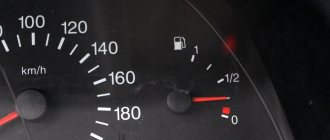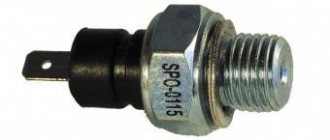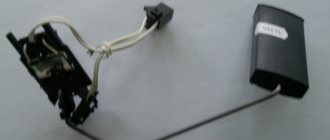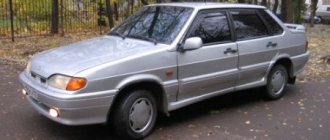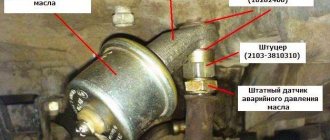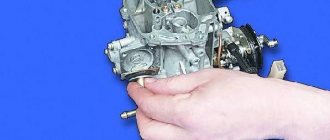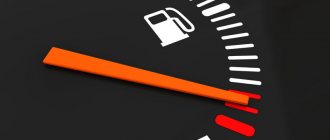How does the RTD work and where is it located?
There are two variants of RTD - mechanical and electrical type. The former are designed as relief valves (vacuum type), allowing excess fuel to flow back at high pressure. The second option is a pressure sensor that transmits information to the control unit.
Today, in a car, the pressure regulator is located in one of two locations:
- Fuel rail. The unit is connected to the inlet and outlet lines. The first supplies gasoline/diesel from the tank, the second drains excess fuel - in this way low pressure is obtained in the fuel rail.
- In the tank on the pump module. The fuel, having established compression, enters the engine without the use of an additional hose. Gasoline/diesel fuel, with this arrangement, discharged into the tank does not heat up.
The regulator consists of:
- Cases. It is made of metal. Durable and airtight. This prevents fuel leakage and pressure loss.
- Membranes. At high pressure, it slightly opens the fuel line to drain the fuel.
- Check valve. It is located at the input of the device.
- Springs. It presses on the valve diaphragm.
- Fittings. Fuel inlet and outlet lines are secured.
- Sealing elements. Responsible for tightness.
On a note! The mechanical regulator works due to the pressure difference. In a number of systems, instead of an RTD, a solenoid valve controlled by the engine ECU is used.
A mechanical RTD is a valve on which pressure from different sides is exerted by fuel and a spring. If the speed is low, the valve opens, allowing fuel to drain into the tank. Then the pump turns on, pumping fuel through the filter.
Location of the RTD in the fuel rail of the vehicle
The use of a special regulator for the fuel system is associated with the need to reduce or increase the pressure of fuel supply to the engine when it operates at different speeds. For example, idling requires a very small amount of fuel, while as the speed increases, the intensity of its injection should increase.
In order to equalize this difference on all injectors, the device is installed at the end of the fuel rail. As standard, it is mounted in the fuel rail. Very often, its location can be changed - for example, the RTD is placed in a return hose or even in a tank.
Placement in the gas tank makes it possible to avoid the need to install additional fuel lines, and the check valve blocks excess fuel from entering the system. Regardless of the location, the RTD performs the same function, which is to support the fuel pressure required and safe for the vehicle engine.
This is interesting: What is Uber and how to use it correctly? 3 simple steps to order a taxi
For systems without fuel recirculation, the RTD is located in the fuel tank and is designed to maintain the same fluid pressure relative to atmospheric pressure. The specificity of this arrangement is that the differences between the fuel pressures in the tank and in the intake manifold will not be constant, which is ultimately taken into account in the duration of injection of the working fluid.
Functions
RTD is an element of the fuel system (hereinafter referred to as TS), which is responsible for the level of fuel pressure determined by the operating mode of the automobile engine. RTDs are used in injection-type engines, for which the accuracy of parameters during fuel injection is important.
The purpose of the unit is to maintain fuel pressure by regulating the fuel supply to the cylinders, which ensures optimal operation of the injectors.
If the RTD is faulty, the acceleration time increases and even the motor power decreases. If the volume of air from the manifold remains stable, and the amount of fuel increases, then the fuel-air mixture either does not ignite or does not burn 100%.
Video about RTD
The fuel pressure regulator is an element of the injection engine power system, which allows you to maintain the required fuel pressure in the fuel injectors at different operating modes of the internal combustion engine. In other words, the overall performance of the injectors and the stability of the engine depend on the serviceability of the fuel pressure regulator (FPR).
Considering that the pressure regulator is actually a diaphragm valve, failure of this element can greatly affect the operation of the engine. In this article we will look at the principle of operation of the regulator, highlight the main signs of its malfunction, and also talk about how to check the fuel pressure regulator.
Read in this article
Causes of malfunctions
There are not many reasons why the fuel regulator fails. The element cannot be called ultra-reliable; it works, as they say, under wear and tear, and is very dependent on the quality of the fuel.
Causes of breakdowns:
- Marriage. This is not a common reason, but sometimes you come across defective products from domestic automakers. It is recommended to check the spare part before purchasing.
- Wear. Usually observed after 100-200 thousand kilometers. In the regulator, the membrane becomes less elastic, the pressure control valve gets stuck, and the spring becomes weaker.
- Bad fuel. Gasoline and diesel car engine fuel often contains too much moisture, debris, and foreign toxins. Water in fuel causes rusting of the metal parts of the regulator. Increasing over time, they interfere with its normal functioning and lead to weakening of the spring.
- The fuel filter is clogged. Garbage fractions in the fuel clog the system, including the RTD, and become clogged. This leads to spring wear and valve jamming.
On a note! RTDs are usually not repaired, but replaced with a new one. But, if the cause of the breakdown is clogging, it can be cleaned.
Signs of RTD malfunction
There are a number of signs of vehicle engine operation that can be used to determine that the RTD is out of order. The most common among them are:
- unstable operation of the power unit (it stalls), in which the fuel fluid pressure level is stable and the other systems are working normally;
- there is a decrease in motor sensitivity;
- there are jerks and failures in the operation of the power unit, which is especially noticeable in motion;
- the level of harmfulness (presence of CH and CO) of exhaust gases increases;
- fuel consumption increases;
- There are difficulties starting the engine.
Also, if malfunctions occur in the RTD, there may be an increase in fuel consumption and leaks of working fluid on the system hoses, which cannot be solved by installing new clamps and replacing tubes. If the symptoms of malfunction described above appear, it is useful for each driver to be able to check the fuel pressure regulator.
Failure options
The regulator is a simple device from a technical point of view, so there are few breakdowns that can happen to it. In almost all cases it is recommended to replace the RTD.
What can break:
- Spring. This is the main failure in the RDT. Due to the weakening of the spring, the engine becomes “starved”, there is not enough fuel at high speeds, when the clutch is pressed and during transient conditions.
- Pollution. When clogged, the ability to pass fuel is lost. The engine stops in any operating mode. If the RTD is heavily contaminated, the pressure in the vehicle rises sharply and fuel leaks through the sealing material. The problem is solved by pumping a large amount of fuel into the fuel pump.
- Jammed. The RTD in the ramp may periodically jam. The car twitches.
Symptoms of breakdowns
Knowing the signs of a malfunction of the DT regulator, you can immediately determine the level of the problem - whether the unit, mechanical or electronic, has completely failed or partially. But all the “symptoms” listed below do not differentiate a regulator breakdown from other faults - they may also indicate a breakdown of the fuel pump or a clogged filter.
Signs of RTD failure are the same for gasoline and diesel engines:
- The engine does not start. The starter spins for a long time when the clutch pedal is pressed.
- The engine stalled at idle. To keep it running you have to press the gas pedal all the time. The second option is instability of speed, leading to engine shutdown.
- Power is lost. The car cannot drive up the mountain and cannot cope with the load. Simply put, “it doesn’t work.”
- Fuel is consumed more than normal. Losses depend on the nuances of the malfunction.
- Fuel is leaking from the hoses. Moreover, replacing hoses or clamps, as well as other closely located elements, does not help.
If at least one symptom appears, a diagnosis is needed.
In new cars, the regulator is the fuel pressure sensor in the rail. If it fails, an error occurs in the ECU memory and the LED lights up, signaling a motor failure.
On a note! Errors regarding the RTD are listed under numbers p2293 and p0089 - “mechanical fault” and “controller faulty”, respectively.
Fuel pressure regulator malfunctions
Problems in the engine power system can vary. For this reason, during diagnosis it is necessary to look for certain signs of a malfunctioning fuel pressure regulator. Most often, the main symptoms are considered to be when the engine does not pick up speed and does not develop full power, and also stalls in different operating modes. In the list of main signs, experts note:
- unstable operation at idle, the unit stalls at idle;
- loss of power, noticeable increase in fuel consumption;
- slow reactions to pressing the gas pedal;
- jerks and dips during acceleration, at the moment of throttling;
- the car does not accelerate, does not gain momentum;
Note that the malfunction of the RTD on gasoline cars is similar in symptoms to common problems with the fuel pump or its strainer. For this reason, when determining faults in the power system, a mandatory check of the fuel pressure regulator is necessary.
In other words, if the car stalls at idle, the engine power is lost, dips appear, the car jerks during acceleration or when changing gears, significant fuel consumption is noted, then the problem may not only be in the fuel pump grid, the motor or its relay, but also in the fuel pressure regulator.
Regulator malfunctions usually come down to the fact that the spring loses the required force, as a result of which the fuel is prematurely drained into the “return”, and the engine simply does not have enough fuel when you press the gas and increase the speed, as well as in transient modes. It turns out that the pressure in the fuel rail when the fuel pressure regulator spring is faulty is low, as a result of which the engine runs unstably, engine power decreases, the ECU is not able to correctly adjust the mixture composition for different operating modes, etc.
It is also worth noting that a decrease in throughput, as well as blockage of the RTD, is also possible. With such a malfunction, the engine stalls regardless of the operating mode of the internal combustion engine. If the regulator is heavily clogged, then the pressure in the system increases and fuel begins to pour out through the sealing elements at the joints. The fact is that car manufacturers always take into account the possibility of a decrease in the performance of the pump and injectors. To solve the problem, the gas pump always pumps fuel “with a reserve”. If draining into the return line is difficult for some reason, then the excess fuel cannot return to the fuel tank, and as a result the pressure increases.
Failures in the operation of the RTD are also possible when the pressure regulator in the fuel rail begins to jam at certain intervals. In such cases, pressure drops occur in the fuel supply system, and the car begins to twitch. Let us add that the most common reasons for regulator failure, which results in signs of malfunction of the fuel pressure regulator on a diesel or gasoline car, also include wear and tear of the materials inside the device, that is, the valve simply wears out its service life over time. The service life and condition of the regulator are affected by the quality of the fuel and the content of various impurities in it, long periods of vehicle downtime without starting the engine, etc.
Diagnostics
There are a number of methods to diagnose the condition. All of them are simple, even a novice car enthusiast can handle them.
Test methods:
- Visually. This is an option for carburetor engines. Pinch the valve or disconnect it. The fault can be determined by how intense the fuel flow is. The method is simple, but inaccurate.
- Pressure gauge. Install the device between the fitting and the hose, temporarily disconnecting the vacuum hose. The reading on the pressure gauge should rise to 0.7 bar.
- By pinching the hose. Check the RTD by clamping the return line. The pressure gauge should respond immediately. If the engine does not rev up, the governor is faulty. Start the engine by clamping the return line. Watch the speed and listen to his work. If its operation is uniform, the adjustment valve is faulty - it must be replaced.
The procedure for checking the performance of an RTD depends on its type - mechanical and electrical components are checked differently.
How to check a mechanical regulator:
- locate the fuel return hose under the hood;
- start the engine - let it run for a minute to warm up a little;
- using pliers - very carefully, pinch the return hose;
- if after clamping the engine begins to work well, then the problem is a broken RTD.
It is forbidden to pinch the hoses for a long time - this creates additional stress on the pump, which leads to its breakdown in the future.
In injection engines, fuel hoses are made of metal rather than rubber to increase reliability. Electrical sensors in such systems are made on the basis of strain gauges. To determine if the RTD on the injector is faulty, check the voltage at the sensor output.
In diesel engines, RTDs are checked by measuring the resistance of the sensor inductor. Usually the normal value is around 8 ohms. If the resistance is noticeably higher, or vice versa, much lower than stated, the regulator is broken. Detailed diagnostics are carried out only in the service center - at special stands where sensors and the entire fuel supply system are checked.
Repair process
The fuel pressure regulator is replaced according to the following scheme:
- The pressure in the internal combustion engine power system is relieved.
- Carefully remove the vacuum hose from the fuel pressure regulator and unscrew the nut that secures the fuel drain pipe.
- The bolts intended to secure the unit are turned out.
- The regulator is removed from the fuel supply pipe. In this case, you need to make sure that the O-ring remains on it.
- Install a new part by performing the above sequence of actions, only in reverse order.
Timely diagnosis of problems with the fuel pressure regulator and its correct replacement will prevent more serious engine damage associated with improper fuel supply.
